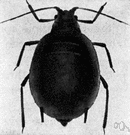a·phis
(ā′fĭs, ăf′ĭs)n. pl. a·phi·des (ā′fĭ-dēz′, ăf′ĭ-)
An aphid, especially one of the genus Aphis.
[New Latin Aphis, genus name.]
American Heritage® Dictionary of the English Language, Fifth Edition. Copyright © 2016 by Houghton Mifflin Harcourt Publishing Company. Published by Houghton Mifflin Harcourt Publishing Company. All rights reserved.
aphis
(ˈeɪfɪs)n, pl aphides (ˈeɪfɪˌdiːz)
1. (Animals) any of various aphids constituting the genus Aphis, such as the blackfly
2. (Animals) any other aphid
[C18: from New Latin (coined by Linnaeus for obscure reasons)]
Collins English Dictionary – Complete and Unabridged, 12th Edition 2014 © HarperCollins Publishers 1991, 1994, 1998, 2000, 2003, 2006, 2007, 2009, 2011, 2014
a•phis
(ˈeɪ fɪs, ˈæf ɪs)n., pl. a•phi•des (ˈeɪ fɪˌdiz, ˈæf ɪ-)
an aphid, esp. of the genus Aphis.
[1765–75; < New Latin]
Random House Kernerman Webster's College Dictionary, © 2010 K Dictionaries Ltd. Copyright 2005, 1997, 1991 by Random House, Inc. All rights reserved.
ThesaurusAntonymsRelated WordsSynonymsLegend:
| Noun | 1. |  Aphis - type genus of the Aphididae: injurious to fruit trees and vegetables Aphis - type genus of the Aphididae: injurious to fruit trees and vegetablesarthropod genus - a genus of arthropods Aphididae, family Aphididae - small soft-bodied plant lice Aphis pomi, apple aphid, green apple aphid - bright green aphid; feeds on and causes curling of apple leaves |
Based on WordNet 3.0, Farlex clipart collection. © 2003-2012 Princeton University, Farlex Inc.